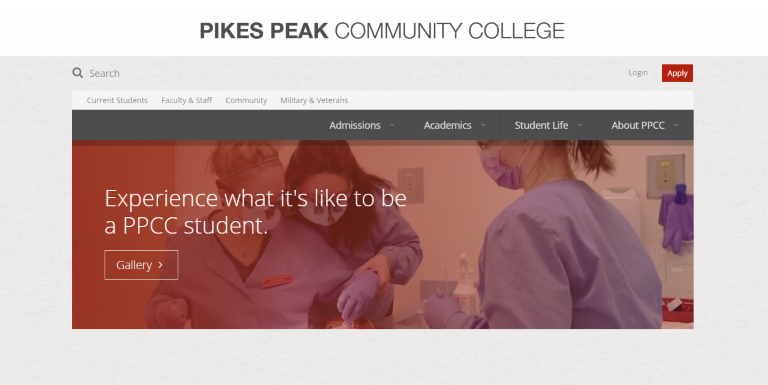Pikes Peak Community College: A New Website That Drives Enrollment

Pikes Peak Community College’s (PPCC) website was in sad shape. Designed in 2010, it was not mobile first, its navigation confusing, and the feedback from students and others universally negative.
In May 2015, a four-person PPCC marketing team decided to take on a redesign in partnership with the IT department. The first question team members asked themselves as they designed the new website was: Who is our primary audience? But finding an answer to that question was tougher than they expected. PPCC, like other community colleges, has many audiences: faculty, staff, students, prospective students, and community members. Determining the most significant audience was a challenge.
Many colleges create websites that try to serve everyone. Others consider that the target user should be the ones who use the website the most. Using Google Analytics, it is easy to identify existing students as primary users. Current students use college sites to shop for classes, explore different majors, determine bookstore hours, or find out when student government is meeting.
PPCC chose a different direction. The development team selected as the college’s primary audience potential students. The reason: They are not the most common users of the site, but they are the most important and serve as a baseline. One of any college’s primary goals is to drive enrollment. For that reason, the team decided to use videos, graphs, and other imagery to answer key questions that potential students have: Will I fit in? Can I afford it? Does the institution offer what I want to study? The team also recognized that, for this audience, internal structure and nomenclatures mean nothing. For their user experience to be optimal, the names and paths used on the website must be intuitive to the average person with no college experience.
The team also, however, included specific, intuitive paths for those with a bit more experience: current students, faculty, and community members, with distinctive tabs at the top of each Web page, above the primary navigation bar, to ensure ease of navigation.

The updated PPCC site launched in the summer of 2016 and has been a tremendous success. From June through December, the number of user sessions jumped from 1,069,889 to 1,225,397, a 14.53 percent increase. More importantly, the website helped drive application growth by 6.5 percent.
At a fall communications conference, the Colorado Community College System office gave a seminar about how to create optimum college websites. The presenter showed sites from a few Ivy League schools. Then, somebody said, “These sites are great, but we don’t have that kind of money. Do you have any suggestions for how we can create a site on a community college budget?” The presenter, then, showed PPCC’s website and spent the next hour deconstructing what makes it good, the clear target audience, the intuitive navigation, and the use of video even on interior pages.
PPCC’s marketing team is proud of the website, but they did not create it alone. Development was completed with the assistance of individuals not only from the IT department, but also those from all around the college. It takes a village, or in this case close collaboration with content experts like faculty and staff in advising, foreign languages, mathematics, clubs, the radio station, etc. With hundreds of pages to create and maintain, the team knew they needed to create a shared ownership plan.
Six months before the site launch and for several months after, the development team held tutorials with each college division, teaching administrators, faculty, and staff how to use the content management system: Concrete 5. Over the past year, the college divisions have been writing, posting photos and videos, and updating their portions of the website.
Since July 1, 2016, site developers have also been working to boost (Search Engine Optimization), and test variations of the site to get better results. One feature added in November 2016 is a PPCC blog. It features award news, new student groups, program development, and success stories. This mixture of stories is, then, pushed out through social media, driving more traffic to the site.
The blog serves as an internal public relations tool. When a department does something extraordinary, they come to the marketing department to help get the word out. Some of the articles are put out to the community via press releases for the local media. But more often, the news is internal, and a blog helps people throughout the college feel as if they’ve been heard. The blog also helps with SEO, as Google likes dynamic websites with a constant stream of fresh content.
From this point forward, maintaining the site will take focus and discipline. Every constituency has different needs, and requests come in monthly. The college, however, has been diligent about keeping our focus on the potential student, recognizing that not only is the website the primary tool for information, it’s also our post potent calling card.
Warren Epstein is the Executive Director for Marketing and Communication at Pikes Peak Community College in Colorado Springs, Colorado.
Opinions expressed in Member Spotlight are those of the author(s) and/or submitting college and do not necessarily reflect those of the League for Innovation in the Community College.









